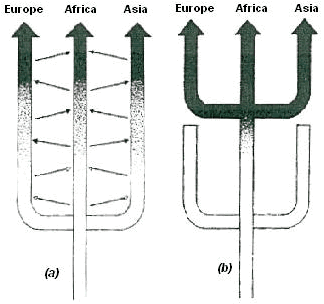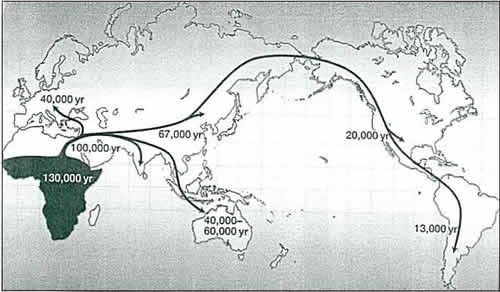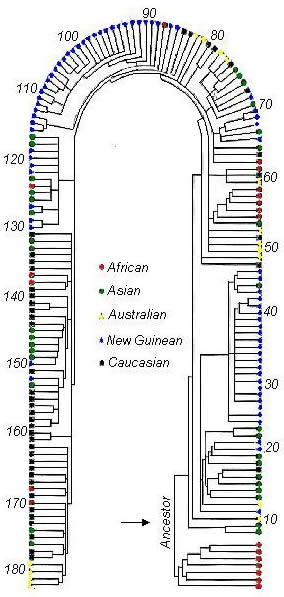Humans are one of the most formidable species on Earth. Our greater intellect and ability to reason sets us apart from other members of the animal kingdom and has allowed us to exploit habitats and resources worldwide. So why, in the age of mankind, is there only one surviving species within the Homo genus? How have modern Homo sapiens come to reign over their archaic forebears, in the course of hominid evolution? Despite being a topic that has dominated evolutionary studies over the last two decades, the origin of modern humans remains enigmatic. Most theories of human evolution are variants of two conflicting models - the "multiregional" model and the "out-of-Africa replacement" (OAR) model. Both explanations accept Africa as the evolutionary origin of the Homo genus and the subsequent migration of these early hominids, Homo erectus, into Europe and Asia around two million years ago. However, the models differ in their account of H. sapiens evolution, which is where the controversy lies. Was Africa the sole place of origin of our own species,s as well as that of our ancestors?
 |
| Figure 1 : Evolutionary models - (a) Multiregional model: Modern humans arise simultaneously in the three populations over time, due to gene flow and genetic continuity (b) OAR model: Lineages in Europe and Asia are supplanted by the African lineage, with little or no hybridisation between groups. |
The multiregional model proposes that modern humans evolved simultaneously in different regions of the Old World from populations of archaic humans (Homo erectus). A single, dominant species, Homo sapiens, is the outcome of this "parallel evolution" as gene flow between populations is possible (figure 1a). Under this model, specific regional characteristics are retained in each geographically dispersed population of modern humans. The out-of-Africa (OAR) model, on the other hand, emphasises replacement as a means of eliciting the spread of Homo sapiens. Proponents of this view hold that a single biological population of anatomically modern humans initially evolved in Africa at some time over the last 100 - 200 thousand years, and then wandered out of Africa, driving the pre-existing hominid populations to extinction (figure 2). Amongst these ancient populations were the Neanderthals of western Eurasia and immediate descendants of Homo erectus, which are thought to have made no genetic contribution to modern humanity (figure 1b). This theory is now thought to be the most likely, based on a growing body of archaeological and, more recently, genetic evidence.
THE CASE AGAINST THE MULTIREGIONAL MODEL A crucial element of the multiregional model is gene flow between modern and archaic humans, which would facilitate synchronous evolution into a single species. However, this fundamental aspect has been challenged primarily due to the lack of transitional fossils in Europe and Asia, which would indicate that such gene flow was taking place. The absence of interbreeding is further confirmed by molecular evidence, such as recent studies of ancient Neanderthal DNA. According to the multiregional theory, Neanderthal DNA should resemble that of Europeans more than the DNA of modern Africans and Asians since Neanderthals (figure 3) were known to have lived in Europe and Western Asia from around 230 - 30 thousand years ago. But in reality, Neanderthal DNA seems to be distinct from all modern human DNA, regardless of race and geography. The extent of genetic difference between the two supports the view that Neanderthals coexisted as a separate species that has gradually been supplanted by modern humans, without contributing to the modern human gene pool.
 |
| Figure 2: Journey of humankind - modern humans originated in sub-Saharan Africa and dispersed within the last 100,000 years (as outlined in the OAR model). |
Molecular studies also emphasise the unique importance of Africa. Evidence suggests that Africans exhibit a higher level of genetic diversity than non-Africans for many mitochondrial and nuclear loci. This implies that the African line has been around for longer than other populations, enabling greater genetic variation to accumulate, which is in agreement with the OAR model.
 |
| Figure 3: Driven to extinction - Neanderthals in Western Eurasia |
MITOCHONDRIAL EVE Nevertheless, the most compelling evidence to date comes from mitochondrial DNA (mtDNA) studies. If modern mankind has evolved from a subpopulation of humans originating in Africa, the notorious figure somewhat misleadingly termed Mitochondrial Eve, may have been amongst these early humans. But who is this elusive female and how has she helped us gradually to unravel our genealogical history?
 |
| Figure 4: A lucky horseshoe for proponents of the OAR model - Genealogical tree for different types of human mtDNA. The black arrow points out the two primary branches, one of which leads exclusively to African individuals, indicated by red circles. The other branch contains all other racial groups as well as Africans. Thus we can infer that the common ancestor ("Mitochondrial Eve") was of African origin. |
Contrary to common misconceptions, Eve was not the sole living female of her time and therefore not the only female ancestor of modern humans. However, she is our most recent common ancestor with respect to matrilineal descent. Mitochondria, the powerhouses of our cells, provide an insight into the female genetic history, as unlike nuclear DNA, mtDNA is not a hotchpotch of sequences derived from both parents but is inherited solely via the maternal lineage. In theory, the mitochondria in the cells of all modern humans could be traced back to a single woman - nicknamed Mitochondrial Eve. Although other females were present during Eve's time, by pure chance, she was the only woman to produce a continuous line of daughters that persists today, reflected in the preservation of her mitochondrial genome.
Due to its rapid mutation rate and uniparental mode of inheritance, mtDNA is a particularly useful tool in evolutionary studies. Under the assumption that any mitochondrial genome diversity is due to mutations alone, and that these random mutations occur at a roughly constant rate, sequence data can be used to approximate when two populations last shared a common ancestor. In this way, phylogenetic trees can be produced.
The pioneering mtDNA studies focused on a control region of the genome termed the D-loop, which has the highest mutational rate. This region was sequenced from individuals distributed around the world, and annual mutation rates estimated, enabling scientists to wind-back our molecular clock to the time of the founder genotype from which all the mitochondrial genotypes in modern humans arose. This technique predicts that Eve lived approximately 150,000 years ago, and was an African female (figure 4).
However, more recent studies have concentrated on the entire mitochondrial genome. The complete genomes of several people from different geographical and racial backgrounds have now been sequenced, yielding evolutionary trees with deep indigenous African roots. As the statistical support for these phylogenies is strong, an African origin for the human mitochondrial gene pool is highly convincing. The ancestral mtDNA from which all modern mtDNAs are derived is thought to have existed in an African population approximately 170,000 years ago, which is consistent with the notion that anatomically modern humans evolved in Africa within the last 200 thousand years. Mitochondrial Eve probably predated the exodus out of Africa, and her mtDNA was amongst the founding population that came to displace archaic populations.
Mitochondrial DNA may provide a picture of maternal genetic history, but as only one genetic locus this is not enough to substantiate an entire theory of human origin. Eve's genetic complement, however, Y-Chromosome Adam corroborates earlier findings. Analyses of Y-chromosome sequences have allowed researchers to uncover the genetic trail leading to an Adam with unmistakeable African roots.
THE FUTURE So, as the evidence mounts in favour of a recent African origin, one might ask why we continue to speculate about our evolutionary history. Why are we still digging if the roots have been unearthed? The answer is that in spite of the facts, there is still no final answer. None of the deductions made thus far are watertight, and the methods and approaches employed are continually being reassessed. For instance, over recent years the assumption that mitochondrial DNA is maternally inherited and thereby free from recombination has been disputed. If sperm mitochondria are found to recombine with mitochondria present in the ovum, the credibility of the mitochondrial evidence may be called into question. Similarly, flaws in the molecular clock technique have been highlighted.
The story is further complicated by the possibility that neither of the principal models (OAR and Multiregional) is correct. The true explanation may be an amalgamation of the two, which is reflected in the alternate "Hybridisation" and "Assimilation" models. These theories tone down the role of replacement in human evolution by incorporating gene flow and hybridisation yet still allow that Africa has a prime position in human genetic history. The exact importance of Africa, and indeed the full narrative, remains to be told. But with further advances in molecular techniques, and the use of alternate gene systems, we may finally be getting closer to solving the mystery of where we came from... ACKNOWLEDGEMENTS - The image of the Neanderthal skull was kindly provided by Ulf Gyllensten of the University of Uppsala, Sweden - Figure 1 was adapted from Philosophical translations: Biological Sciences Vol. 357, No. 1420, 565 (Royal Society 2002) - Figure 2 courtesy of www.nature.com (Nature 408, 7 Dec 2000, p. 653) - The mtDNA tree was adapted from Scientific American, 266/4, 69 (April 1992)
- Previous Science of Love - Cupid's Chemistry
- Next MACHINA - An Overview











Comments
Add a comment